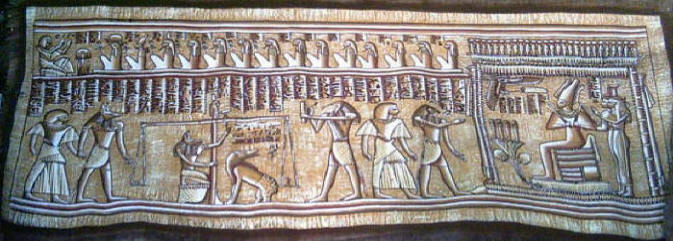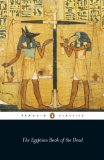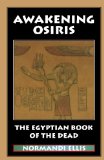Egyptian book of the Dead

"The Book of Dead" is the common name for the ancient Egyptian
funerary text known as "Spells of Coming" (or "Going") "Forth By Day."
The name itself was depicted by the German Egyptologist Karl Richard
Lepsius, who published a selection of the texts in 1842. The Book of the
Dead was a description of the ancient Egyptian conception of the
afterlife and a collection of hymns, spells, and instructions to allow
the deceased to pass through obstacles in the afterlife. The Book of the
Dead was most commonly written on a papyrus scroll and placed in the
coffin or burial chamber of the deceased.
The Book of the Dead does not set forth religious tenets and was not
considered by the ancient Egyptians to be the product of divine
revelation, which allowed the content of the book of the dead to change
over time.
The Book of the Dead was the product of a long process of evolution
from the Pyramid Texts of the Old Kingdom (writings on the crypt walls
intending to help the dead person) to the Coffin Texts of the Middle
Kingdom (similar writings, placed on the outside of a coffin).
Eventually, many of these texts were written on papyrus and placed in
the burial chamber, or inside the coffin with the mummy.
About one-third of the chapters in The Book of the Dead are derived
from the earlier Coffin Texts. The Book of the Dead itself was adapted
to The Book of Breathings in the Late Period, but remained popular in
its own right until the Roman period.
The name for the book in the Egyptian language was rw nw prt m hrw.
This derives from the title of one of the most important spells, spell
17, prt m hrw.
- Rw is the plural of r 'mouth'. R can also refer to a thing said,
such as a piece of speech or in this case a ritual incantation.
- Nw is a form of n 'of'. This 'genitival adjective' grammatically
agrees with the preceding noun. Nw is the masculine dual/plural
form.
- Prt is an action-non derived from the verb prj 'emerge',
'arise'. It expresses the act of emerging or arising.
- M is a preposition typically meaning 'in'. When dealing with
time, it can mean 'during'.
- Hrw means 'day', 'daytime'.
Thus a very literal translation is 'utterances of emergence during
daytime'. A slightly looser translation for sense could be 'spells of
going out in the daytime'.
 
|
 
|
 
|
| The Egyptian Book of the Dead:
The Book of Going Forth by Day - The Complete Papyrus of Ani
Featuring Integrated Text and Full-Color Images
|
The Egyptian Book of the Dead
(Penguin Classics) |
Awakening Osiris: The Egyptian
Book of the Dead |
Order Book
|
Order Book
|
Order Book
|
Books were often prefabricated in funerary workshops, with spaces
being left for the name of the deceased to be written in later. They are
often the work of several different scribes and artists whose work was
literally pasted together. The cost of a typical book might be
equivalent to half a year's salary of a laborer, so the purchase would
be planned well in advance of the person's death.
The history of the main body of religious compositions which form the
Book of Dead of the ancient Egyptians may conveniently be divided into
four of the periods, which are represented by four versions: 1- The
version which was edited by the priests of the college of Annu
(Heliopolis of the Greeks), and which was based upon a series of texts
now lost, but which there is evidence to prove had passed through a
series of revisions or editions as early as the period of the 5th
dynasty. This version was, so far as we know, always written in
hieroglyphics, and may be called the Heliopolitan version. It is known
from five copies which are inscribed upon the walls of the chambers and
passages in the pyramids of kings of the 5th and 6th dynasties at
Sakkâra and sections of it are found inscribed upon tombs, sarcophagi,
coffins, stele and papyri from the 11th dynasty to about A.D. 200. 2-
The Theban version, which was commonly written on papyri in
hieroglyphics and was divided into sections or chapters, each of which
had its distinct title but no definite place in the series. The version
was much used from the 18th to the 20th dynasty. 3- A version closely
allied to the preceding version, which is found written on papyri in the
hieratic character and also in hieroglyphics. In this version, which
came into use about the 20th dynasty, the chapters have no fixed order.
4- The so-called Saïte version, in which, at some period anterior
probably to the 26th dynasty, the chapters were arranged in a definite
order. It is commonly written in hieroglyphics and in hieratic, and it
was much used from the 26th dynasty to the end of the Ptolemaic period.
Modern Publication history of the Egyptian book of the dead:
The earliest manuscripts were published in the aftermath of the
Egyptian expedition led by Napoleon Bonaparte in "Description de
l'Ėgypte" (1821). Jean Francois Champollion was one of the early
translators. In 1842 Karl Richard Lepsius published a version dated to
the Ptolomaic era and coined the name "Book of The Dead", a title not
known or used by the Ancient Egyptians, as well as the chapter numbering
system which is still in use. Samuel Birch published the first English
version in 1867. Edouard Naville published what was to become the first
full standard edition in three volumes (1886). Using the papyrus texts
in the British Museum E. A. Wallis Budge published editions including
the Papyrus of Ani, which Naville had not dealt with, in 1890. Peter le
Page Renouf's English edition was published in parts beginning in 1892.
Budge's hieroglyphic edition was published in 1898 and is still widely
used. Budge's 1901 English translation is still in print. More recent
translations in English have been published by T. G. Allen (1974) and
Raymond O. Faulkner (1972)
|